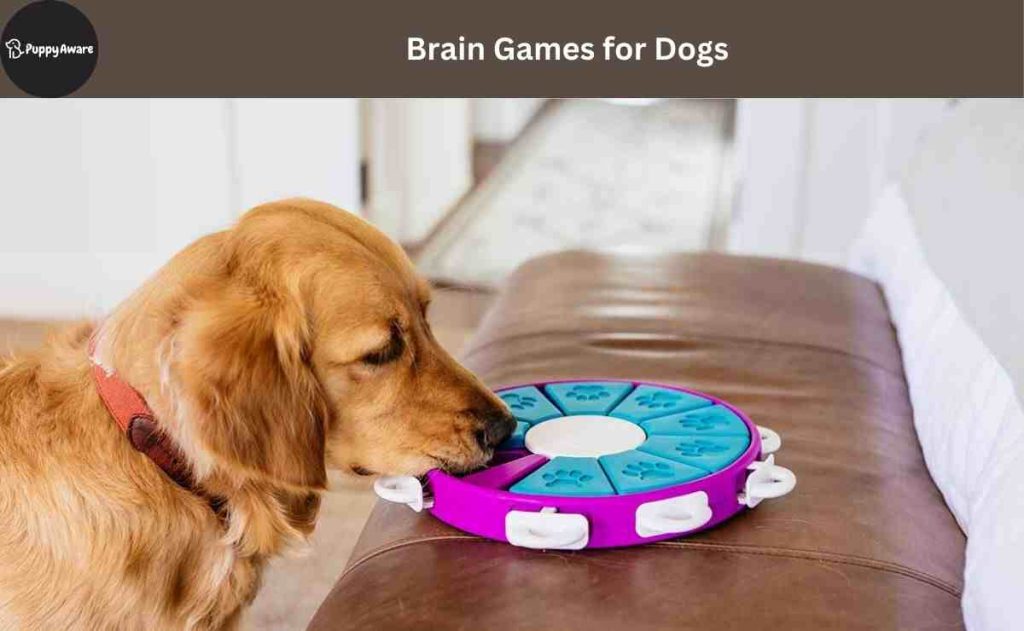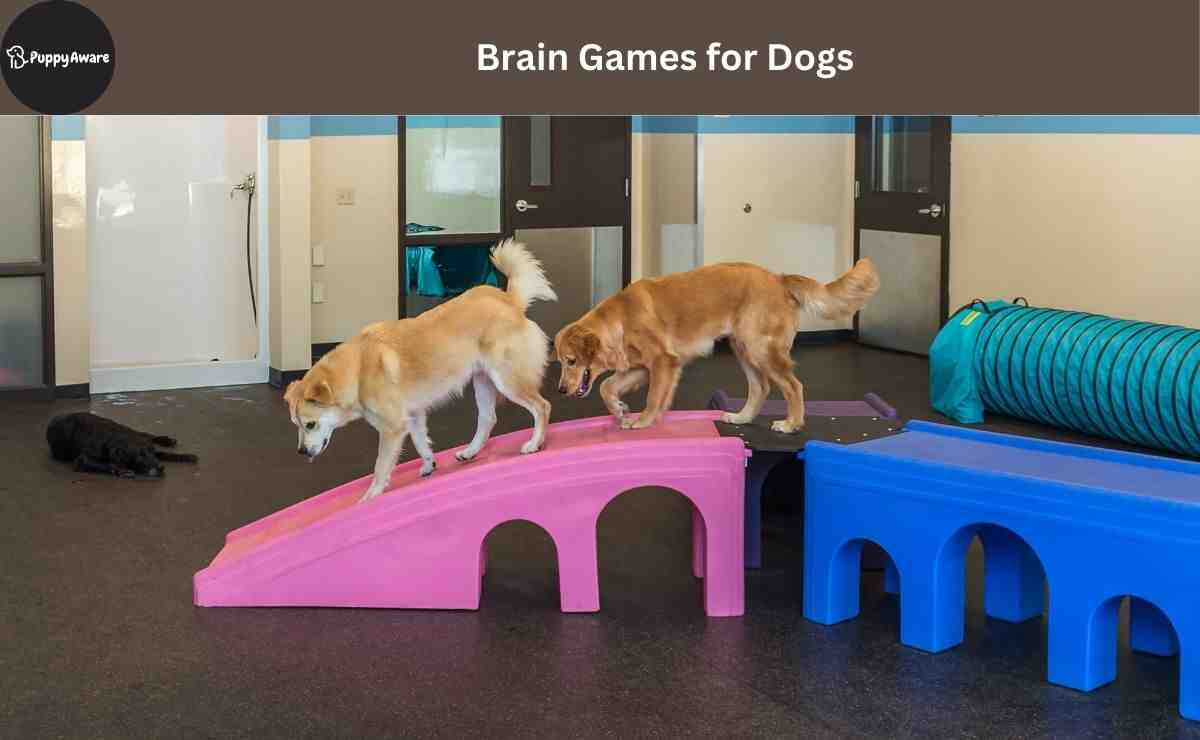Just as humans need mental exercise to stay sharp, our four-legged companions like dogs require cognitive stimulation to maintain their mental well-being.
Research from the University of veterinary medicine in Vienna suggests that dogs who engage in regular mental activities show reduced anxiety, decreased destructive behaviors, and improved overall happiness.
Why Mental Stimulation Matters for Your Dog
Mental stimulation through brain games serves multiple purposes:
- Prevents Cognitive Decline: Regular mental exercise helps maintain neural pathways and can slow down age-related cognitive dysfunction, particularly in senior dogs. Studies have shown that dogs who participate in puzzle-solving activities maintain better cognitive function as they age, similar to how crossword puzzles benefit human seniors.
- Reduces Problem Behaviors: When dogs are mentally tired, they’re less likely to engage in destructive behaviors like excessive barking, chewing furniture or digging. A mentally stimulated dog is typically calmer and more content, as they’ve channeled their energy into productive activities.
- Strengthens the Human-Dog Bond: Interactive brain games create opportunities for positive reinforcement and shared experiences, deepening the connection between you and your furry friend. This quality time spent together enhances trust and communication.
7 Easy Brain Games for Dogs to Boost Mental Fitness

Game 1: The Cup Shuffle Challenge
Difficulty Level: (Beginner)
Time Required: 5-10 minutes
Materials Needed: 3 opaque cups, high-value treats
This classic game taps into your dog’s natural tracking abilities while teaching them patience and focus. Here’s how to play:
- Start with three identical cups turned upside down
- Let your dog watch as you place a treat under one cup
- Slowly shuffle the cups around
- Encourage your dog to find the treat by pointing to the correct cup
- Reward them immediately when they indicate the right cup
Pro Tips:
- Begin with simple, slow movements
- Use treats with strong aromas to maintain interest
- Gradually increase difficulty by shuffling faster or adding more cups
Game 2: Name Game Evolution
Difficulty Level: (Intermediate)
Time Required: 15-20 minutes daily
Materials Needed: Various toys, treats
Unlike traditional fetch, this game develops your dog’s vocabulary and object recognition skills. Research from the Family Dog Project has shown that dogs can learn up to 100 different object names through consistent training.
| Training Stage | Duration | Success Criteria | Common Challenges |
|---|---|---|---|
| Introduction | Week 1-2 | Recognizes 1-2 toy names | Confusion between similar toys |
| Development | Week 3-4 | Identifies 3-5 toys | May lose interest quickly |
| Advanced | Week 5+ | Can select from 6+ toys | Needs frequent reinforcement |
Game 3: The Towel Roll Challenge
Difficulty Level: (Intermediate)
Time Required: 10-15 minutes
Materials Needed: Clean towel, favorite treats or toys
This enrichment activity taps into your dog’s natural foraging instincts while providing a safe outlet for their problem-solving skills.
| Setup Stage | Description | Training Tips | Safety Notes |
|---|---|---|---|
| Beginner | Loosely roll treats in flat towel | Encourage pawing and nosing | Monitor for fabric chewing |
| Intermediate | Create multiple layers | Add verbal cues for encouragement | Use durable towels |
| Advanced | Add toys as obstacles | Reward partial progress | Keep sessions short |
Training Progression
- Phase 1: Start with treats visible at the edge of the towel
- Phase 2: Roll treats completely inside but loosely wrapped
- Phase 3: Create a tighter roll with multiple layers
- Phase 4: Add complexity by placing toys as barriers between treats
Game 4: Interactive Treat Dispensing
Difficulty Level: (Advanced)
Time Required: 20-30 minutes
Materials Needed: Empty plastic bottles, cardboard boxes, treats
This DIY puzzle game combines problem-solving with reward-based learning. A study by the University of Bristol found that dogs who engage in food puzzle activities show increased confidence in problem-solving situations.
Creating Safe DIY Puzzle Toys:
Bottle Puzzle
- Clean and dry an empty plastic bottle
- Remove plastic ring and cap
- Cut small holes for treats to fall through
- Monitor your dog during play to ensure safety
Box Challenge
- Use sturdy cardboard boxes
- Create different-sized openings
- Layer boxes within each other
- Place treats at various difficulty levels
Safety Considerations
- Always supervise puzzle play
- Choose appropriate-sized holes for your dog’s treats
- Replace worn or damaged puzzles immediately
- Select materials that won’t splinter or break
Game 5: The Three-Toy Memory Game
Difficulty Level: (Intermediate)
Time Required: 15 minutes
Materials Needed: 3 different toys, treats
This memory-building exercise helps develop your dog’s cognitive recall abilities and attention span.
| Game Phase | Duration | Objective | Success Indicators |
|---|---|---|---|
| Learning | 5 minutes | Toy recognition | Shows interest in specific toy |
| Memory | 5 minutes | Recall after delay | Finds correct toy when asked |
| Challenge | 5 minutes | Multiple toy memory | Distinguishes between toys |
Scientific Benefits:
Recent studies in canine cognition reveal that memory games can:
- Enhance pattern recognition abilities
- Improve problem-solving skills
- Strengthen neural pathways
- Delay age-related cognitive decline
Game 6: Sound Association Training
Difficulty Level: (Advanced)
Time Required: 10-15 minutes, 3 times daily
Materials Needed: Small bell or clicker, treats, toys
Sound association training takes advantage of your dog’s acute hearing abilities while developing their cognitive mapping skills.
Research from the Journal of Veterinary Behavior indicates that dogs can distinguish between hundreds of different sound patterns.
Training Schedule For Success
| Week | Activity | Duration | Expected Progress |
|---|---|---|---|
| 1 | Basic sound introduction | 5 min sessions | Associates sound with reward |
| 2 | Distance training | 10 min sessions | Responds from different rooms |
| 3 | Multiple sound patterns | 15 min sessions | Distinguishes between sounds |
| 4 | Complex sequences | 15 min sessions | Follows sound-based instructions |
Implementation Steps
Foundation Phase
- Choose distinct sounds for different actions
- Start with one simple sound-reward association
- Practice in a quiet environment
- Reward immediately after correct responses
Advanced Training
- Add distance between you and your dog
- Introduce background noise gradually
- Create sequences of different sounds
- Vary reward types and timing
Game 7: The Clean-Up Challenge
Difficulty Level: (Advanced)
Time Required: 20-30 minutes
Materials Needed: Toy box, various toys, treats
This game combines physical activity with cognitive processing, teaching your dog organizational skills while providing mental stimulation.
Progressive Training Stages
| Stage | Description | Duration | Key Skills Developed |
|---|---|---|---|
| Introduction | Single toy return | 1 week | Basic command recognition |
| Building | Multiple toy sorting | 2 weeks | Object discrimination |
| Mastery | Independent cleanup | 3+ weeks | Task completion |
Teaching Methods
Basic Association
- Show your dog the toy box
- Demonstrate placing toys inside
- Reward any interaction with the box
- Celebrate successful toy deposits
Advanced Training
- Name different toys specifically
- Create a cleanup routine
- Use directional commands
- Practice with various toy types
Expert Tips for Success
- Start with your dog’s favorite toys
- Keep training sessions short and positive
- Use clear, consistent commands
- Gradually increase the number of toys
- Maintain enthusiasm throughout the process
How to Make Brain Games Work for Your Dog
Adapting Games for Different Dog Personalities
Understanding your dog’s unique personality is crucial for successful brain training. Here’s how to modify games based on different temperaments:
| Dog Type | Game Modifications | Special Considerations | Best Starting Games |
|---|---|---|---|
| High Energy | Shorter, more frequent sessions | Include physical movement | Cup Shuffle, Clean-Up Challenge |
| Shy/Anxious | Quieter environment, less pressure | More praise, slower progression | Name Game, Towel Roll |
| Senior Dogs | Simplified versions, longer response time | Focus on comfort | Sound Association, Memory Game |
| Food Motivated | Use varied treats | Monitor calorie intake | Treat Dispensing Games |
Common Challenges and Solutions
Challenge: Short Attention Span
- Solution: Break games into 3-5 minute segments
- Strategy: Use high-value rewards initially
- Progressive Plan: Gradually extend duration as focus improves
Challenge: Frustration During Games
- Solution: Identify early signs of frustration
- Strategy: Simplify the game temporarily
- Prevention: Set achievable difficulty levels
Creating a Brain Game Schedule
Weekly Planning Template:
| Time of Day | Game Type | Duration | Notes |
|---|---|---|---|
| Morning | Simple Memory Games | 5-10 mins | Before breakfast |
| Afternoon | Physical Puzzle Games | 10-15 mins | After walk/exercise |
| Evening | Calming Games | 5-10 mins | Before bedtime |
Safety and Health Considerations
Physical Health Checks:
- Monitor energy levels during games
- Watch for signs of mental fatigue
- Ensure proper hydration
- Adjust difficulty based on age and health status
Environmental Safety:
- Keep playing area clear of hazards
- Use dog-safe materials only
- Maintain proper ventilation
- Consider temperature during active games
Measuring Progress
Track your dog’s development using these key indicators:
| Aspect | What to Monitor | Success Indicators |
|---|---|---|
| Problem Solving | Time to complete tasks | Decreased completion time |
| Memory | Recall accuracy | Improved object recognition |
| Focus | Duration of engagement | Longer attention span |
| Enthusiasm | Eagerness to participate | Increased interest in games |
Advanced Brain Game Techniques and Long-term Benefits
Combining Physical and Mental Exercise
Research from the College of Veterinary Medicine at Tufts University demonstrates that combining physical and mental activities creates optimal stimulation for dogs. Here’s how to integrate both:
| Activity Type | Physical Component | Mental Component | Combined Benefits |
|---|---|---|---|
| Agility Puzzles | Running, Jumping | Direction Following | Enhanced coordination |
| Scent Work | Walking, Digging | Memory, Focus | Improved confidence |
| Obstacle Courses | Climbing, Crawling | Problem Solving | Better body awareness |
Documented Benefits of Regular Brain Training
Recent studies have shown remarkable improvements in dogs who participate in regular mental enrichment:
Behavioral Improvements:
- 68% reduction in destructive behaviors
- 45% decrease in excessive barking
- 72% improvement in general obedience
- 55% reduction in anxiety-related issues
Cognitive Benefits:
- Enhanced memory retention
- Improved problem-solving abilities
- Better emotional regulation
- Increased adaptability to new situations
Creating a Progressive Training Path
Long-term Development Plan:
| Month | Focus Area | Goals | Evaluation Methods |
|---|---|---|---|
| 1 | Basic Games | Master 2-3 simple games | Track completion rates |
| 2-3 | Intermediate | Combine games, increase difficulty | Monitor problem-solving speed |
| 4+ | Advanced | Create complex sequences | Assess independent thinking |
Key Takeaways:
- Start with simpler games and progress gradually
- Maintain consistency in training sessions
- Monitor your dog’s engagement and adjust accordingly
- Celebrate small victories and progress
- Keep safety as the top priority
Final Expert Tips:
- Document your dog’s progress through videos or notes
- Join online communities to share experiences
- Consider seasonal variations in game difficulty
- Rotate games to maintain interest
- Always end sessions on a positive note
Conclusion
Brain games are more than just entertainment—they’re essential tools for developing your dog’s cognitive abilities and strengthening your bond.
By implementing these seven games and following the provided guidelines, you’re investing in your dog’s mental health and overall well-being.
Remember, every dog learns at their own pace, and the journey of mental enrichment is as important as the destination. Through patience, consistency, and positive reinforcement, you’ll help your furry friend develop into a more confident, capable and content companion.
Related Posts
